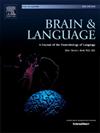橡胶手杂耍,橡胶脚跳跃:动词理解过程中感觉运动的再利用
IF 2.3
2区 心理学
Q1 AUDIOLOGY & SPEECH-LANGUAGE PATHOLOGY
引用次数: 0
摘要
具身认知理论和基础认知理论认为,感觉运动信息的再利用有助于词汇理解。在本研究中,我们诱导了手脚的身体所有权幻觉(以及相关的控制条件),同时参与者对与手脚相关的动词进行分类。利用表征相似度分析(RSA),我们证明了在动词分类过程中,感觉运动信息在控制条件下约600毫秒可解码,而在手部相关动词分类过程中约400毫秒可解码。此外,当参与者经历身体所有权幻觉时,在动词分类过程中引发的感觉运动活动模式发生了改变;当感觉运动信息被幻觉预先激活时,解码就会提前。总的来说,我们的研究结果表明,预激活感觉运动信息改变了支持动词理解的神经动力学,为重复使用感觉运动信息的神经认知过程提供了证据。这些结果有助于具身认知和基础认知模型的发展,并为神经重用的动力学提供了见解。本文章由计算机程序翻译,如有差异,请以英文原文为准。
Juggling with rubber hands, leaping with rubber feet: Sensorimotor reuse during verb comprehension
Theories of embodied and grounded cognition suggest that the reuse of sensorimotor information supports word comprehension. In the current study, we induced body ownership illusions of the hands and feet (and related control conditions) while participants categorized verbs related to the hands and feet. Using representational similarity analysis (RSA) we demonstrate that sensorimotor information is decodable during verb categorization at around 600 ms in control conditions and around 400 ms for hand related verbs specifically. Further, the pattern of sensorimotor activity elicited during verb categorization is altered when participants experience body ownership illusions; decoding is earlier when sensorimotor information was pre-activated with illusions. Overall, our results suggest that preactivating sensorimotor information alters the neural dynamics supporting verb comprehension, providing evidence for a neurocognitive process that reuses sensorimotor information. These results contribute to the development of models for embodied and grounded cognition and provide insight into the dynamics of neural reuse.
求助全文
通过发布文献求助,成功后即可免费获取论文全文。
去求助
来源期刊

Brain and Language
医学-神经科学
CiteScore
4.50
自引率
8.00%
发文量
82
审稿时长
20.5 weeks
期刊介绍:
An interdisciplinary journal, Brain and Language publishes articles that elucidate the complex relationships among language, brain, and behavior. The journal covers the large variety of modern techniques in cognitive neuroscience, including functional and structural brain imaging, electrophysiology, cellular and molecular neurobiology, genetics, lesion-based approaches, and computational modeling. All articles must relate to human language and be relevant to the understanding of its neurobiological and neurocognitive bases. Published articles in the journal are expected to have significant theoretical novelty and/or practical implications, and use perspectives and methods from psychology, linguistics, and neuroscience along with brain data and brain measures.
 求助内容:
求助内容: 应助结果提醒方式:
应助结果提醒方式:


